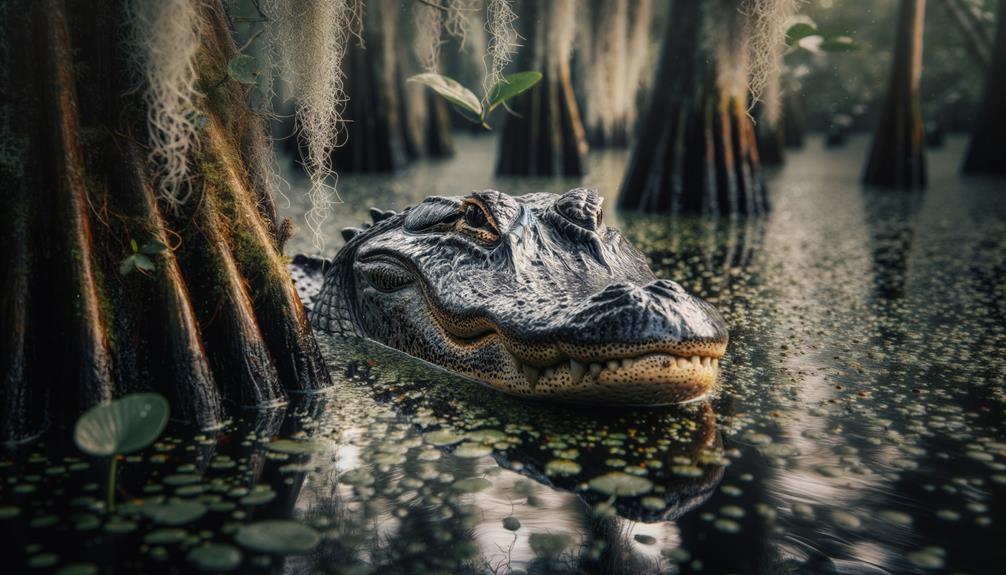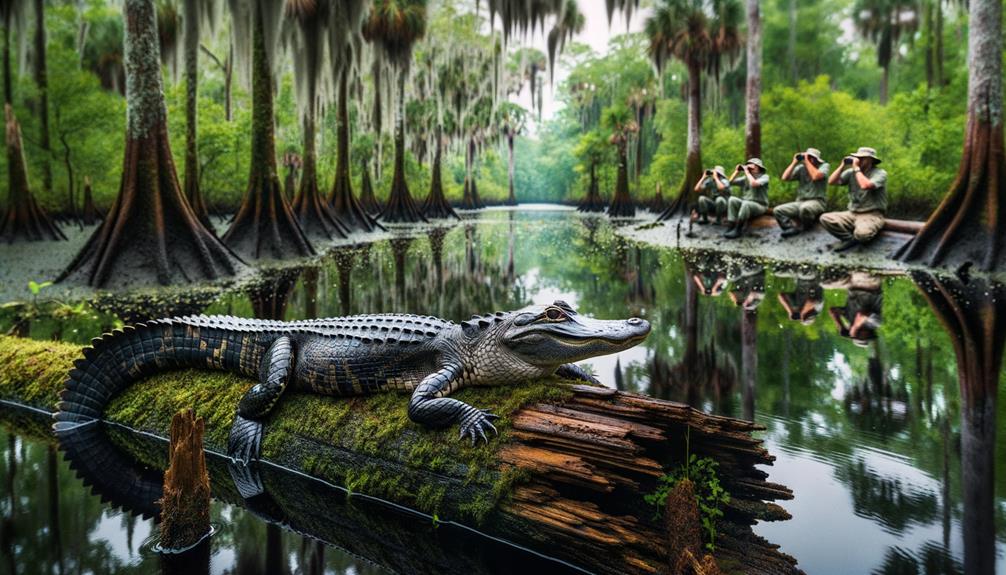I've always been fascinated by how American alligators have adapted so perfectly to their swampy habitats, showcasing their remarkable survival skills and resilience. These reptiles thrive in diverse wetlands across the southeastern United States, with cypress swamps being their primary homes. They regulate their body temperature by basking in the sun and enter a state of dormancy during cooler months. Female alligators build nests from vegetation and fiercely protect their hatchlings, which make high-pitched sounds to get attention. As apex predators, they maintain the balance of their ecosystems by controlling prey populations. Thanks to conservation efforts, their once-endangered status has improved significantly. There's still much to learn about these fascinating swamp survivors.
Key Takeaways
American alligators thrive in cypress swamps, where they find shelter and an abundance of food. By basking in the sun, they regulate their body temperature, a vital adaptation for survival in swamp environments. Males engage in aggressive territorial and mating behaviors, ensuring that the strongest individuals dominate and increase their chances of survival. Female alligators protect their young for up to two years, significantly improving hatchling survival rates. Thanks to conservation efforts, including regulated hunting and farming, wild alligator populations have stabilized and even increased.
Habitat and Range
Across the southeastern United States, American alligators thrive in diverse wetland habitats, from Louisiana's vast coastal marshes to Florida's cypress swamps. These reptiles embody the wild beauty and resilience found at the water's edge. In North America, the American alligator is particularly abundant, with Louisiana and Florida each boasting populations exceeding one million.
In Louisiana alone, coastal marshes cover over 3 million acres, providing a rich and varied habitat for these apex predators. Alligators inhabit ponds, lakes, canals, rivers, and swamps, each environment supporting different aspects of their life cycle. Mature males and non-breeding females often prefer deeper waters, while nesting females and young alligators are more commonly found in shallow marsh areas.
The American alligator reigns supreme in the cypress swamps, which stretch across several thousand square kilometers in Louisiana, Georgia, and Florida. Their presence is a fundamental indicator of the health of these ecosystems. Once threatened by overhunting, successful conservation and management efforts have allowed alligator populations to rebound, making them a triumph in wildlife management and a symbol of untamed freedom in North America's wetlands.
Adaptations and Behavior

American alligators have evolved remarkable adaptations and behaviors that enable them to thrive in diverse wetland habitats. As cold-blooded creatures, they regulate their body temperature by basking in the sun, a crucial behavior for survival. Male alligators, often exceeding 13 feet and 500 pounds, grow faster and larger than females, giving them an advantage in territorial disputes and mating battles.
Alligators exhibit a fascinating seasonal rhythm. During the cooler months, they become dormant, conserving energy due to their slow metabolism. This dormancy helps them survive when food is scarce. As the temperature rises, their activity increases, and they become more aggressive, especially during mating season.
Three key adaptations and behaviors contribute to their success:
- Thermoregulation: By basking in the sun, alligators maintain an ideal body temperature.
- Size and Strength: Larger males have an edge in dominance and survival.
- Seasonal Dormancy: Reduced activity during winter helps conserve energy.
Their aggressive nature during mating often leads to violent fights, resulting in scars or even missing limbs. Once eggs hatch, young hatchlings face a perilous start, but they benefit from the protective instincts of their formidable parents. These adaptations ensure American alligators remain formidable swamp survivors.
Reproduction and Nesting

Female American alligators carefully build nests using marsh vegetation, laying up to 60 eggs within these structures. The temperature of the nest determines the sex of the hatchlings: warmer temperatures produce males, while cooler temperatures produce females.
When the eggs hatch, the young alligators make a distinctive chirping sound. This call prompts the mother alligator to help break open the eggs and carry the hatchlings to the water. The bond between the mother and her young is crucial for their survival, as they face high mortality rates due to predators like raccoons and birds.
| Nest Characteristics | Hatchling Behavior |
|---|---|
| Made of marsh vegetation | Chirping to signal mother |
| Up to 60 eggs (four dozen) | Assisted by mother alligator |
| Temperature-dependent sex | Carried to water by mother |
Young alligators remain under their mother's watchful eye for up to two years, learning essential skills to survive. Despite this protection, only a few of these juveniles reach adulthood, with many falling prey to natural threats. Alligators typically become breeding adults when they grow to around six feet in length, ensuring the continuation of their populations and the resilience of their species.
Role in Ecosystem

In cypress swamps, alligators play a crucial role in maintaining the delicate balance of these unique ecosystems. As apex predators, they keep populations of various species, from small fish to diving ducks, in check. By using dense aquatic grasses as cover, alligators can ambush prey effectively, including waterfowl that come to feed on the weeds and aquatic life.
Their hunting techniques are fascinating. They move closer to diving ducks underwater, taking advantage of the ducks' reduced vision to capture them. This method highlights the alligator's adaptability and underscores their importance in the food web. Without alligators, the ecosystem could face drastic imbalances.
Consider these three key points:
- Population Management: Alligators help regulate the numbers of small fish and ducks, ensuring no single species dominates.
- Habitat Preservation: Their predation activities contribute to the health of aquatic vegetation and overall habitat.
- Maternal Instinct: When young alligators are threatened, their distress calls signal to the mother, showcasing the protective behaviors essential for species survival.
In essence, alligators are a real threat to prey species, but their role is indispensable for the ecological harmony of cypress swamps.
Conservation Efforts

Recognizing the crucial role alligators play in maintaining ecosystem balance, conservation initiatives have been vital in reviving their populations across the southeastern United States. These apex predators, once declared endangered, now thrive due to dedicated conservation efforts. Louisiana's alligator management program serves as a prime example. By combining regulated wild harvesting with commercial farming, it sustainably meets the demand for alligator meat and leather, ensuring that wild populations remain healthy and vibrant.
Alligator hunting seasons, typically lasting two months, are carefully regulated in many states to maintain sustainable population levels. These measures not only protect alligators but also support local economies and traditions. The revenue generated from hunting permits and the sale of alligator products funds further conservation efforts, creating a beneficial cycle.
Alligator farms, along with the use of wild-caught alligators, provide a reliable source for the exotic leather and meat industries. This reduces pressure on wild populations, securing their continued survival. Over the past seven years, these combined efforts have demonstrated remarkable success, proving that with careful management and community involvement, humans can coexist with these magnificent creatures while preserving our natural heritage.
Frequently Asked Questions
How Many People Are Injured by Alligators in the Us?
Every year, Florida sees around 8-15 alligator attack injuries. While these incidents can be serious, they're quite rare, considering the large alligator population in the state. The risk of being attacked remains low for most people.
How Many American Alligators Are Left?
When I look at the current alligator population, I'm struck by the remarkable recovery. Estimates suggest there are several thousand to over 2.5 million American alligators thriving across the southeastern United States, a testament to effective conservation efforts.
Does the American Alligator Have Any Predators?
You might think that an apex predator like the American alligator has no natural enemies, but that's not entirely true. While adult alligators are at the top of their food chain, their eggs and young are vulnerable to predators like raccoons, opossums, bobcats, and birds of prey.
Who Was the Elderly Lady Killed by Two Alligators in Florida?
The elderly lady killed by two alligators in Florida was 85-year-old Dorothy Clayre. She was tragically attacked and dragged into the water while walking her dog near a pond in Englewood, a stark reminder of the dangers that lurk in the wild.



